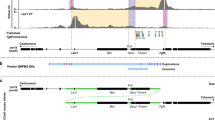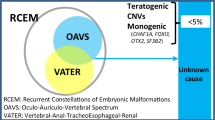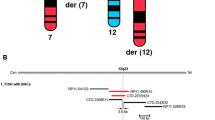Abstract
We report on three patients with split hand/foot malformation type 1 (SHFM1). We detected a deletion in two patients and an inversion in the third, all involving chromosome 7q21q22. We performed conventional chromosomal analysis, array comparative genomic hybridization and fluorescence in situ hybridization. Both deletions included the known genes associated with SHFM1 (DLX5, DLX6 and DSS1), whereas in the third patient one of the inversion break points was located just centromeric to these genes. These observations confirm that haploinsufficiency due to either a simultaneous deletion of these genes or combined downregulation of gene expression due to a disruption in the region between these genes and a control element could be the cause of the syndrome. We review previously reported studies that support this hypothetical mechanism.
Similar content being viewed by others
Log in or create a free account to read this content
Gain free access to this article, as well as selected content from this journal and more on nature.com
or
References
Bernardini L, Palka C, Ceccarini C et al: Complex rearrangement of chromosome 7q21.13–q22.1 confirms the ectrodactyly-deafness locus and suggests new candidate genes. Am J Med Genet A 2008; 146A: 238–244.
Basel D, Kilpatrick MW, Tsipouras P : The expanding panorama of split hand foot malformation. Am J Med Genet A 2006; 140A: 1359–1365.
Lo Iacono N, Mantero S, Chiarelli A et al: Regulation of Dlx5 and Dlx6 gene expression by p63 is involved in EEC and SHFM congenital limb defects. Development 2008; 135: 1377–1388.
de Mollerat XJ, Gurrieri F, Morgan CT et al: A genomic rearrangement resulting in a tandem duplication is associated with split hand-split foot malformation 3 (SHFM3) at 10q24. Hum Mol Genet 2003; 12: 1959–1971.
Ianakiev P, Kilpatrick MW, Toudjarska I, Basel D, Beighton P, Tsipouras P : Split-hand/split-foot malformation is caused by mutations in the p63 gene on 3q27. Am J Hum Genet 2000; 67: 59–66.
van Bokhoven H, Hamel BC, Bamshad M et al: p63 Gene mutations in eec syndrome, limb-mammary syndrome, and isolated split hand-split foot malformation suggest a genotype-phenotype correlation. Am J Hum Genet 2001; 69: 481–492.
Scherer SW, Poorkaj P, Massa H et al: Physical mapping of the split hand/split foot locus on chromosome 7 and implication in syndromic ectrodactyly. Hum Mol Genet 1994; 3: 1345–1354.
Scherer SW, Poorkaj P, Allen T et al: Fine mapping of the autosomal dominant split hand/split foot locus on chromosome 7, band q21.3–q22.1. Am J Hum Genet 1994; 55: 12–20.
Cobben JM, Verheij JBGM, Eisma WH et al: Bilateral split hand/foot malformation and inv(7)(p22q21.3). J Med Genet 1995; 32: 375–378.
Elliott AM, Evans JA : Genotype-phenotype correlations in mapped split hand foot malformation (SHFM) patients. Am J Med Genet A 2006; 140A: 1419–1427.
Wieland I, Muschke P, Jakubiczka S, Volleth M, Freigang B, Wieacker PF : Refinement of the deletion in 7q21.3 associated with split hand/foot malformation type 1 and Mondini dysplasia. J Med Genet 2004; 41: e54.
Robledo RF, Rajan L, Li X, Lufkin T : The Dlx5 and Dlx6 homeobox genes are essential for craniofacial, axial, and appendicular skeletal development. Genes Dev 2002; 16: 1089–1101.
Bongers EMHF, de Wijs IJ, Marcelis C, Hoefsloot LH, Knoers NVAM : Identification of entire LMX1B gene deletions in nail patella syndrome: evidence for haploinsufficiency as the main pathogenic mechanism underlying dominant inheritance in man. Eur J Hum Genet 2008; 16: 1240–1244.
Crackower MA, Scherer SW, Rommens JM et al: Characterization of the split hand/split foot malformation locus SHFM1 at 7q21.3–q22.1 and analysis of a candidate gene for its expression during limb development. Hum Mol Genet 1996; 5: 571–579.
Jantti J, Lahdenranta J, Olkkonen VM, Soderlund H, Keranen S : SEM1, a homologue of the split hand/split foot malformation candidate gene Dss1, regulates exocytosis and pseudohyphal differentiation in yeast. Proc Natl Acad Sci USA 1999; 96: 909–914.
Duijf PHG, van Bokhoven H, Brunner HG : Pathogenesis of split-hand/split-foot malformation. Hum Mol Genet 2003; 12: R51–R60.
Kobayashi K, Sinasac DS, Iijima M et al: The gene mutated in adult-onset type II citrullinaemia encodes a putative mitochondrial carrier protein. Nat Genet 1999; 22: 159–163.
Crackower MA, Sinasac DS, Xia J et al: Cloning and characterization of two cytoplasmic dynein intermediate chain genes in mouse and human. Genomics 1999; 55: 257–267.
Okita C, Meguro M, Hoshiya H, Haruta M, Sakamoto YK, Oshimura M : A new imprinted cluster on the human chromosome 7q21–q31, identified by human-mouse monochromosomal hybrids. Genomics 2003; 81: 556–559.
Horike S, Cai S, Miyano M, Cheng JF, Kohwi-Shigematsu T : Loss of silent-chromatin looping and impaired imprinting of DLX5 in Rett syndrome. Nat Genet 2005; 37: 31–40.
Schule B, Li HH, Fisch-Kohl C, Purmann C, Francke U : DLX5 and DLX6 expression is biallelic and not modulated by MeCP2 deficiency. Am J Hum Genet 2007; 81: 492–506.
Nakashima N, Yamagata T, Mori M, Kuwajima M, Suwa K, Momoi MY : Expression analysis and mutation detection of DLX5 and DLX6 in autism. Brain Dev 2009; doi:10.1016/j.braindev.2008.12.021.
Weimer J, Kiechle M, Wiedemann U et al: Delineation of a complex karyotypic rearrangement by microdissection and CGH in a family affected with split foot. J Med Genet 2000; 37: 442–445.
Palmer SE, Scherer SW, Kukolich M et al: Evidence for locus heterogeneity in human autosomal dominant split hand/split foot malformation. Am J Hum Genet 1994; 55: 21–26.
Tzschach A, Menzel C, Erdogan F et al: Characterization of a 16 Mb interstitial chromosome 7q21 deletion by tiling path array CGH. Am J Med Genet A 2007; 143A: 333–337.
Szatmari P, Paterson AD, Zwaigenbaum L et al: Mapping autism risk loci using genetic linkage and chromosomal rearrangements. Nat Genet 2007; 39: 319–328.
Yang MS, Gill M : A review of gene linkage, association and expression studies in autism and an assessment of convergent evidence. Int J Dev Neurosci 2007; 25: 69–85.
Bhanot P, Brink M, Samos CH et al: A new member of the frizzled family from Drosophila functions as a Wingless receptor. Nature 1996; 382: 225–230.
Gazit A, Yaniv A, Bafico A et al: Human frizzled 1 interacts with transforming Wnts to transduce a TCF dependent transcriptional response. Oncogene 1999; 18: 5959–5966.
Riccomagno MM, Takada S, Epstein DJ : Wnt-dependent regulation of inner ear morphogenesis is balanced by the opposing and supporting roles of Shh. Genes Dev 2005; 19: 1612–1623.
Tavares AT, Tsukui T, Izpisua Belmonte JC : Evidence that members of the Cut/Cux/CDP family may be involved in AER positioning and polarizing activity during chick limb development. Development 2000; 127: 5133–5144.
Scherer SW, Cheung J, MacDonald JR et al: Human chromosome 7. DNA sequence and biology. Science 2003; 300: 767–772.
Acknowledgements
We are grateful to the patients and their parents and thank Mrs Jackie Senior for editing the paper.
Author information
Authors and Affiliations
Corresponding author
Rights and permissions
About this article
Cite this article
van Silfhout, A., van den Akker, P., Dijkhuizen, T. et al. Split hand/foot malformation due to chromosome 7q aberrations(SHFM1): additional support for functional haploinsufficiency as the causative mechanism. Eur J Hum Genet 17, 1432–1438 (2009). https://doi.org/10.1038/ejhg.2009.72
Received:
Revised:
Accepted:
Published:
Issue date:
DOI: https://doi.org/10.1038/ejhg.2009.72
Keywords
This article is cited by
-
The molecular genetics of human appendicular skeleton
Molecular Genetics and Genomics (2022)
-
Phenotypic subregions within the split-hand/foot malformation 1 locus
Human Genetics (2016)
-
Deletions of exons with regulatory activity at the DYNC1I1 locus are associated with split-hand/split-foot malformation: array CGH screening of 134 unrelated families
Orphanet Journal of Rare Diseases (2014)
-
Split-hand/foot malformation - molecular cause and implications in genetic counseling
Journal of Applied Genetics (2014)
-
Balanced into array: genome-wide array analysis in 54 patients with an apparently balanced de novo chromosome rearrangement and a meta-analysis
European Journal of Human Genetics (2011)



